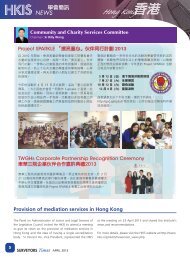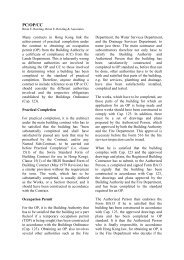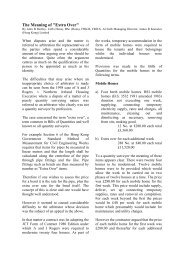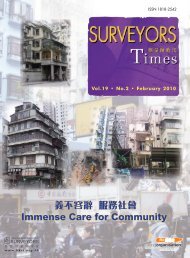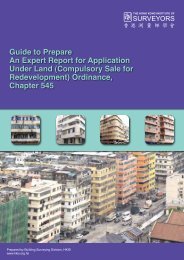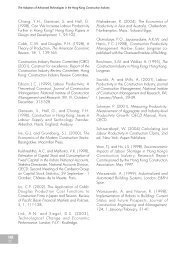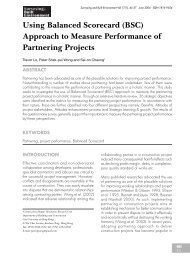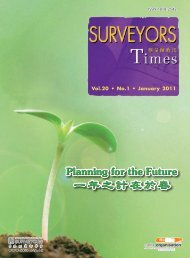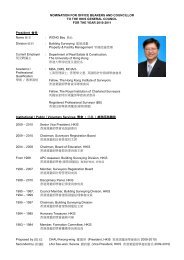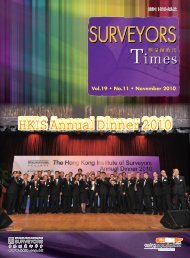Surveying & Built Environment Vol. 22 Issue 1 (December 2012)
Surveying & Built Environment Vol. 22 Issue 1 (December 2012)
Surveying & Built Environment Vol. 22 Issue 1 (December 2012)
You also want an ePaper? Increase the reach of your titles
YUMPU automatically turns print PDFs into web optimized ePapers that Google loves.
SBE<br />
44<br />
Good Property Valuation in Emerging Real Estate Markets? Evidence from Ghana<br />
who had given up their land for the<br />
Boankra Inland Port Project 5 . However,<br />
in such cases, the Land Valuation<br />
Division usually adopts a severely<br />
limited concept of compensation. It<br />
typically uses the Crop Enumeration<br />
Method to assess compensation for<br />
farmers from whom land is taken by the<br />
state. The method entails counting how<br />
many crops are destroyed (enumeration)<br />
and multiplies the total number by the<br />
value of the crops, as assessed by the<br />
Ministry of Food and Agriculture. The<br />
method fails to compensate for any<br />
other inconvenience, as stipulated in the<br />
State Lands Act, Act 125. Where the<br />
Land Valuation Division considers the<br />
land value, it makes reference to only<br />
the market value and ignores the cost of<br />
disturbance in its assessment (see Larbi,<br />
2008). Therefore, court cases of the<br />
value estimates from the state valuer<br />
do not provide much help to valuers.<br />
In any case, valuers find it difficult to<br />
use parcels of state land as comparables<br />
because, as with customary interests<br />
in land, they are governed by multiple<br />
laws, an estimated 26 – excluding about<br />
56 subsidiary legislations - as of 1999<br />
(See details in MLF, 1999, PP. 20-25).<br />
It is within this difficult context that<br />
valuers have to execute their duty of<br />
carrying out valuations of real property<br />
in Ghana. How they negotiate these<br />
complexities, which methods they<br />
use, and what adjustments they make<br />
warrant careful analysis.<br />
VAluATIoN IN GHANA<br />
The Department of Land Economy<br />
based at Kwame Nkrumah University<br />
of Science and Technology, the<br />
Department of Real Estate and<br />
Land Management, University<br />
for Development Studies, and the<br />
Department of Estate Management at<br />
Kumasi Polytechnic are the leading<br />
academic centres for the training<br />
of valuers in Ghana. Both centres<br />
train students in all five traditional<br />
methods of valuation, namely Market<br />
Comparison, Investment, Residual,<br />
Profit, and Cost. Of these methods,<br />
the Cost approach is widely regarded<br />
as the least accurate. The experienced<br />
valuers who authored the famous<br />
Modern Methods of Valuation note that<br />
the ‘[Cost Method] is limited in terms<br />
of providing a valuation…’ (Johnson<br />
et al., 2000, p.18). When should the<br />
Cost Method be used? According to<br />
the authors, only when all the other<br />
methods are inapplicable:<br />
Within the wide range of properties<br />
which exist there are some which<br />
are designed and used for a<br />
special purpose to meet specific<br />
requirements and which are outside<br />
the general range of commercial<br />
and residential properties. Typical<br />
examples are churches, town<br />
halls, schools, police stations and<br />
other similar properties which<br />
perform non-profitable community<br />
functions…..such properties are<br />
rarely sold and, when they are, they<br />
generally need to be replaced by<br />
alternative premises which have to<br />
be newly built since alternatives<br />
5<br />
The project, in which this author was involved as an observer, entailed a plan to develop large parcels of<br />
land in the Ejisu Juaben district of the Ashanti region of Ghana.



